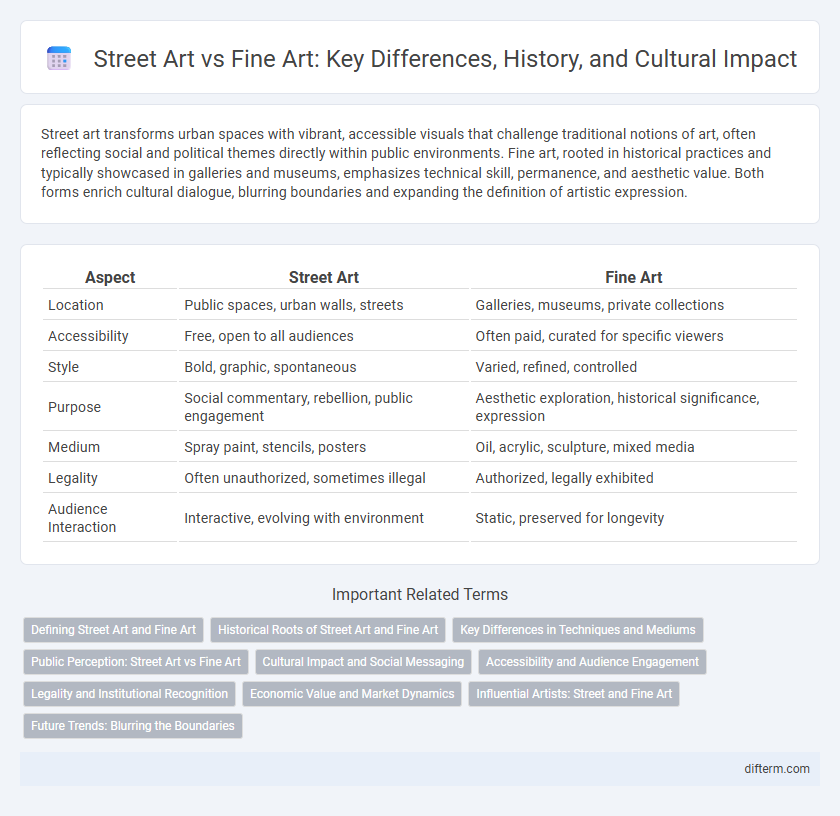Street art transforms urban spaces with vibrant, accessible visuals that challenge traditional notions of art, often reflecting social and political themes directly within public environments. Fine art, rooted in historical practices and typically showcased in galleries and museums, emphasizes technical skill, permanence, and aesthetic value. Both forms enrich cultural dialogue, blurring boundaries and expanding the definition of artistic expression.
Table of Comparison
| Aspect | Street Art | Fine Art |
|---|---|---|
| Location | Public spaces, urban walls, streets | Galleries, museums, private collections |
| Accessibility | Free, open to all audiences | Often paid, curated for specific viewers |
| Style | Bold, graphic, spontaneous | Varied, refined, controlled |
| Purpose | Social commentary, rebellion, public engagement | Aesthetic exploration, historical significance, expression |
| Medium | Spray paint, stencils, posters | Oil, acrylic, sculpture, mixed media |
| Legality | Often unauthorized, sometimes illegal | Authorized, legally exhibited |
| Audience Interaction | Interactive, evolving with environment | Static, preserved for longevity |
Defining Street Art and Fine Art
Street art encompasses visual artworks created in public spaces, often characterized by graffiti, murals, and stencil art that challenge traditional art boundaries and engage urban audiences directly. Fine art refers to creative expressions such as painting, sculpture, and drawing, typically produced for aesthetic appreciation and displayed in galleries or museums. Both forms use distinct techniques and contexts, with street art emphasizing social commentary and accessibility, while fine art prioritizes formal training, art history, and curated presentation.
Historical Roots of Street Art and Fine Art
Street art traces its origins to ancient cave paintings and graffiti in urban spaces, evolving as a form of public expression and social commentary, distinct from the institutional settings of fine art. Fine art, rooted in Renaissance traditions, emphasizes classical techniques and formal training within galleries and museums, reflecting cultural and aesthetic ideals of its time. Both art forms share historical significance yet diverge in their modes of creation, audience engagement, and cultural contexts.
Key Differences in Techniques and Mediums
Street art utilizes spray paint, stencils, and wheat-pasting on public surfaces, emphasizing accessibility and urban engagement. Fine art relies on traditional mediums like oil paint, charcoal, and canvas, prioritizing detailed craftsmanship and longevity. The spontaneous, often rebellious nature of street art contrasts with the deliberate, methodical approach inherent in fine art techniques.
Public Perception: Street Art vs Fine Art
Street art often faces public perception as an unconventional and rebellious form of expression, frequently associated with urban culture and social commentary. Fine art, by contrast, is traditionally regarded as prestigious, created by academically trained artists and showcased in museums and galleries, reflecting established cultural values. Public acceptance varies, with street art gaining increasing recognition for its accessibility and immediacy, while fine art maintains a reputation for sophistication and enduring aesthetic value.
Cultural Impact and Social Messaging
Street art reshapes urban landscapes by directly engaging diverse communities and amplifying marginalized voices through accessible, vivid imagery. Fine art, often showcased in galleries and museums, carries profound historical and cultural narratives that influence elite cultural discourses and institutional values. Both forms challenge societal norms, with street art fostering grassroots activism while fine art shapes intellectual and aesthetic paradigms.
Accessibility and Audience Engagement
Street art thrives in public spaces, breaking traditional gallery boundaries and offering immediate accessibility to diverse urban audiences. Fine art, often housed in museums and galleries, attracts a more specialized audience, emphasizing curated experiences and historical context. The interactive nature of street art fosters spontaneous community engagement, while fine art demands contemplative viewing.
Legality and Institutional Recognition
Street art often operates outside legal boundaries, frequently resulting in unauthorized public displays that challenge traditional notions of property and public space. Fine art, by contrast, benefits from established institutional recognition, including galleries, museums, and formal art markets, which confer legal protections and validate artistic value. Legal distinctions impact the preservation, commodification, and cultural legitimacy of both art forms, shaping their roles within contemporary artistic ecosystems.
Economic Value and Market Dynamics
Street art has increasingly gained economic value through limited edition prints, commissioned murals, and high-profile auctions, challenging traditional fine art markets. Fine art maintains robust market dynamics with established galleries, collectors, and auction houses dictating prices, yet street art's accessibility and cultural relevance attract new investor demographics. Market trends reveal street art's rapid appreciation rates, while fine art sustains long-term value stability and prestige in global art ecosystems.
Influential Artists: Street and Fine Art
Banksy revolutionized street art with provocative stenciled works that challenge social and political norms, making public spaces a canvas for activism. In fine art, Pablo Picasso reshaped modern aesthetics through Cubism, influencing countless artists across disciplines and eras. Both artists exemplify how street art and fine art serve as powerful cultural commentaries within their respective domains.
Future Trends: Blurring the Boundaries
Emerging future trends in art highlight a significant blurring of boundaries between street art and fine art, as artists increasingly integrate urban graffiti techniques with traditional gallery practices. Digital platforms and augmented reality are enabling street art to gain recognition within prestigious art institutions, fostering hybrid creations that challenge conventional categorizations. This convergence drives a dynamic evolution in artistic expression, emphasizing cultural inclusivity and expanding accessibility beyond traditional fine art audiences.
Street art vs Fine art Infographic

 difterm.com
difterm.com